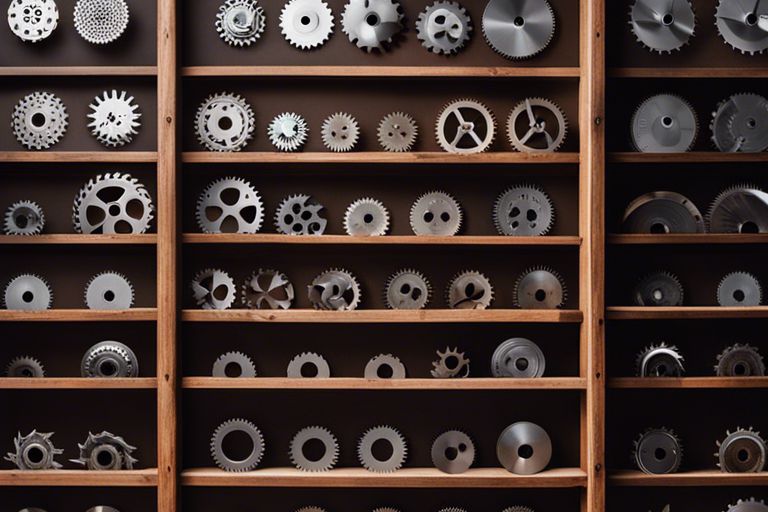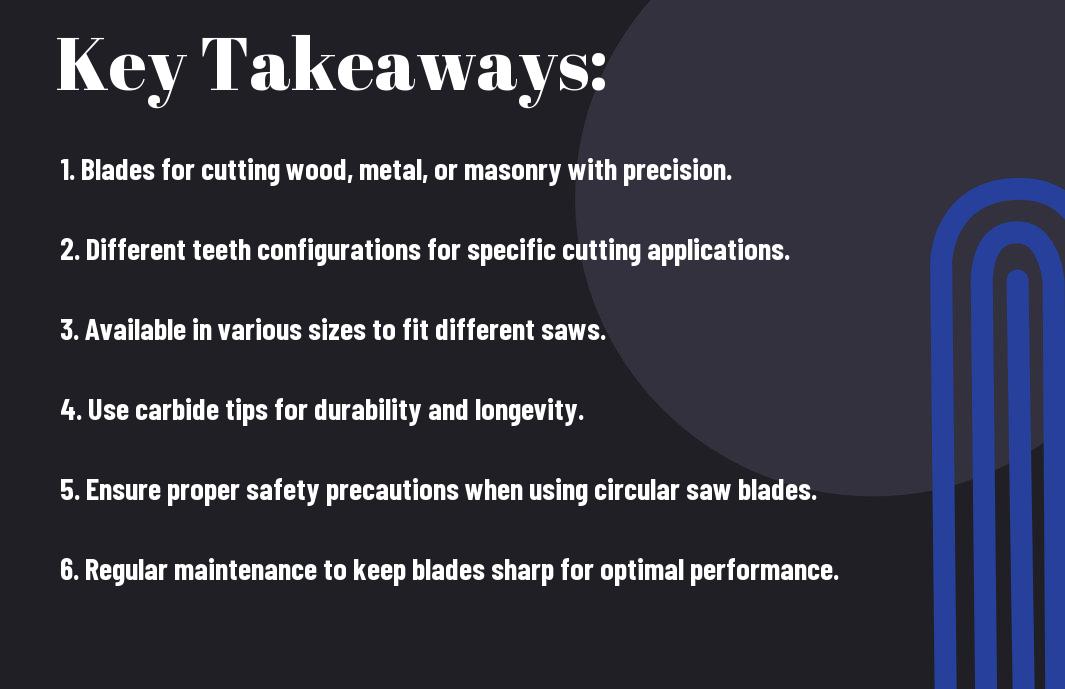What circular saw blades

Saw blades are imperative components of circular saws, designed to cut through various materials with precision and efficiency. Choosing the right circular saw blade for your project is crucial as it can affect the quality of the cut, the safety of the operation, and the overall outcome. These blades come in different sizes, materials, and tooth designs to suit different cutting tasks, from woodworking to metal fabrication. Understanding the types of circular saw blades available and their specific uses can help you achieve optimal results while ensuring safety during operation. Let’s examine deeper into what circular saw blades are and how to select the perfect one for your needs.
Key Takeaways:
- Circular saw blades are vital tools used in woodworking and construction industries for cutting various materials such as wood, metal, masonry, and plastic.
- Choosing the right circular saw blade depends on factors such as blade diameter, number of teeth, material being cut, and type of cutting task (crosscutting, ripping, or plywood cutting).
- Maintaining and replacing circular saw blades regularly is important to ensure optimal cutting performance, safety, and longevity of the tool.

Types of Circular Saw Blades
Some of the most crucial components of a circular saw are the circular saw blades. These blades come in a variety of types and are designed for different cutting applications.
| Standard Blades for Wood Cutting | Specialized Blades for Different Materials |
Standard Blades for Wood Cutting
Blades designed for wood cutting are the most commonly used circular saw blades. They are typically made of high-speed steel or carbide and are ideal for cutting through various types of wood with precision and efficiency.
Specialized Blades for Different Materials
Materials such as metal, concrete, tile, or plastic require specialized blades for cutting. These blades are designed with specific tooth configurations and materials to ensure optimal performance and longevity when cutting through these tougher materials.
To ensure safety and efficiency when using specialized blades for different materials, it is crucial to select the appropriate blade for the specific material you are cutting. Using the wrong blade can result in damaged equipment, inaccurate cuts, or even injury. Always refer to the manufacturer’s guidelines for the correct blade selection.
Blade Features and Specifications
Understanding Blade Diameter and Arbor Size
For a circular saw blade, it’s crucial to match the diameter and arbor size to your specific saw. An incorrectly sized blade can be dangerous and cause damage to your equipment. Make sure to check your saw’s specifications and choose a blade that suits its requirements for optimal performance.
Tooth Count and Kerf Width
Width of the blade indicates the number of teeth on the circular saw blade and the kerf width it produces. A higher tooth count results in a smoother cut, while a lower count is more suitable for rough cuts. The kerf width determines the amount of material removed during each pass. Consider the type of cuts you will be making to select the appropriate tooth count and kerf width for your project.
The tooth count on a circular saw blade can range from as low as 24 teeth for rough cuts to over 100 teeth for fine finishing. The kerf width is the slot cut by the blade in the material and influences the efficiency of the cut. It’s crucial to choose the right combination of tooth count and kerf width for the specific material and finish you desire.
Maintenance and Safety
Proper Blade Cleaning and Storage
Now, when it comes to maintaining your circular saw blades, safety should always be a top priority. After using the blades, make sure to clean them thoroughly to remove any built-up debris, pitch, or resin. Properly store the blades in a protective case or sheath to prevent any damage or accidents while not in use.
Safety Tips for Using Circular Saw Blades
Safety is paramount when operating circular saw blades. Before starting any cutting job, ensure that the blade is sharp and in good condition. Always wear appropriate safety gear such as gloves, goggles, and ear protection to prevent injury. Avoid wearing loose clothing and tie back long hair to prevent accidents. After cutting, wait for the blade to stop completely before making any adjustments or handling the saw.
Cleaning: Proper cleaning and storage of circular saw blades can extend their lifespan and performance. After each use, remove any sawdust, resin, or debris to maintain the blade’s sharpness and cutting efficiency.
- Inspect the blade: Before use, check for any signs of damage or wear on the blade.
- Secure workpiece: Make sure the workpiece is firmly secured before cutting to prevent kickback or accidents.
- Follow manufacturer’s instructions: Always adhere to the guidelines provided by the manufacturer for safe and proper blade usage.
Tips: Always prioritize safety when using circular saw blades. Regularly inspect and clean your blades to ensure optimal performance and longevity. Following proper safety measures can help prevent accidents and injuries while working with power tools.
Blade Selection and Usage
Matching Blades to Cutting Tasks
Keep in mind that selecting the right circular saw blade for your cutting task is crucial for achieving the best results. Whether you are cutting wood, metal, plastic, or other materials, using the appropriate blade will ensure a clean and efficient cut. Consider the material type, thickness, and desired finish when choosing the blade.
Techniques for Optimal Blade Performance
To ensure optimal blade performance, it is important to follow some key techniques. Blades should be kept sharp and clean to prevent accidents and achieve precise cuts. Proper blade installation and regular maintenance are necessary to extend the blade’s lifespan and ensure consistent cutting performance.
Performance of saw blades can be enhanced by adjusting the speed of the saw to match the blade’s specifications. Feeding the material steady and not forcing the blade through the material will also help prevent the blade from binding and ensure a smooth cut.

Summing up
Drawing together different types of circular saw blades allows for a better understanding of their diverse uses and specifications. Whether you’re cutting wood, metal, or other materials, choosing the right blade type and teeth pattern is crucial for achieving desired results. For more information on basic circular saw blade types, teeth patterns, and uses, visit Basic Circular Saw Blade Types, Teeth Patterns and Uses.
FAQ
Q: What are circular saw blades?
A: Circular saw blades are a type of cutting tool designed for use with circular saws. These blades are circular in shape with teeth around the edge, and they are used to cut materials such as wood, metal, plastic, and masonry.
Q: How do I choose the right circular saw blade?
A: Selecting the correct circular saw blade depends on the material you will be cutting and the type of cut you want to achieve. Consider factors such as blade diameter, number of teeth, tooth configuration, and the material the blade is made from. Make sure to match the blade specifications with your saw’s capabilities.
Q: What are the different types of circular saw blades?
A: There are various types of circular saw blades, each designed for specific materials and cutting applications. Some common types include rip blades for cutting along the grain, crosscut blades for cutting across the grain, combination blades for versatile use, and specialty blades for cutting metals, plastics, or masonry.




